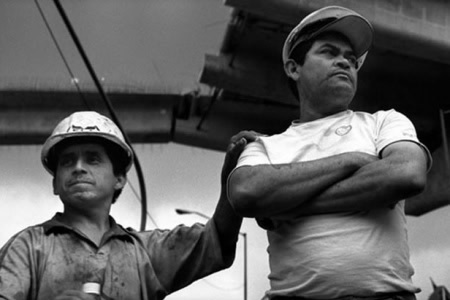To relieve the congestion of Mexico City’s notoriously clogged streets and highways, an upper deck was added to part of the anillo periférico, the urban beltway that rings the sprawling federal district. A monumental public works project, the elevated highway is a seemingly impossible agglomeration of concrete girders, steel cables, and asphalt that, when finished, puts drivers at tree-top level for ten and half miles. From April 2003 through December 2005, Mexican filmmaker Juan Carlos Rulfo visited the construction site, getting to know a small cadre of workers and interviewing them about their lives and the harrowing work.
The resulting documentary, En el Hoyo (In the Pit), went on to win multiple awards on the festival circuit, wowing both juries and audiences with its crisp images and vertiginous camerawork, in particular for its penultimate scene, an extended helicopter shot that tracks along the unfinished network of bridges, hovering just high enough to make out the hundreds of other workers and vast quantities of materiel required for such a massive undertaking. The documentary is shot primarily by Rulfo himself on DVCam with some Super 16mm and 35mm time-lapse footage. As virtuoso as his cinematography is, it is the director’s eye (and ear) for rich character portrayal that makes In the Pit so compelling.
The director never probes them about their relationship other than to inquire about their general views on love and marriage.
Early on, two captivating polar opposites emerge as the documentary’s “stars,” one gruff and gregarious, the other reserved and elusive. Chabelo, the quiet one (Isabel Dolores Hernandez), is singled out from the beginning by the men as different. He first appears as he arrives for work one morning and immediately the razzing begins — he is in constant need of a shower. ”I am very clean,” he counters as he puts on a pair of mud-caked work boots. Carried in a bulldozer to where he will spend the day doing “everything,” he sits next to El Grande (José Guadalupe Calzada), definitely one of the boys, whose constant chatter about his rocky relationship with his mother, his estranged wife (whom he beat), the corrupt Mexican system, the hellishness of the work, and his ignominious past as a womanizing drug dealer entertains throughout the documentary. One grabs the other affectionately on the nape of the neck; the other tries to return the public display and is rebuffed. Wait. Is this the first evidence of a tender but inhibited love between the men?
A later scene (embedded above) reinforces the possibility. Chabelo makes his way to take a break with the other men down in the pit where El Grande is holding forth, obscenely, and has just staked a claim on another man’s sister. “What are you talking about?” the man responds. “What you like is dick!” A focus on Chabelo’s feminine saunter, shouts of “They are going to get married” when caught in a caring moment — instances like these accumulate across the 84-minute running time. Yet, by the end of the documentary, the nature of their relationship remains ambiguous. True to stereotype, the construction workers engage in relentless lewdness among themselves and shout out hopeful obscenities to female passersby. “Today, [the view] is only legs,” one halfheartedly complains. They address each other in vulgar, disparaging ways, and it becomes difficult to separate the posturing machismo from the veritable clues.
Rulfo’s previous film, a 1999 portrait of his father, author of the classic of world literature ‘Pedro Páramo’, did not attempt to define Juan Rulfo (who left behind a scant two books but thousands of photographs). Rather, he demonstrated how poorly others remember him, how they filtered out all but what befits the memory of a literary legend. For Rulfo fils, the point is his characters’ ineffability, their immense complexity, and our desire to draw firm borders around them.
The director never probes them about the nature of their relationship—offering instead careful juxtapositions that make their own suggestions. He never confronts either man; only inquiring about their general views on love and marriage, as he does for most of the other characters. (Chabelo predictably demurs, saying marriage is not for him, and shoots back at Rulfo, “And you?”) He takes his camera off-site to observe others in their homes or at their hobbies, but not for Chabelo or El Grande. Rulfo’s previous film, a 1999 portrait of his father, author of the classic of world literature Pedro Páramo, did not attempt to define Juan Rulfo (who left behind a scant two books but thousands of photographs). Rather, he demonstrated how poorly others remember him, how they filtered out all but what befits the memory of a literary legend. For Rulfo fils, the point is his characters’ ineffability, their immense complexity, and our desire to draw firm borders around them.
Tellingly, In the Pit’s final scene is not the stunning “money” shot that sweeps the uncompleted second deck. Rulfo chooses to end on a much less flashy sequence: following Chabelo at the end of the day as he makes his way to the subway, the only form of transportation that will probably ever carry him home. He is alone. Chabelo rides out of view, still an enigma. Like the legions of invisible men and women whose blood and sweat have made possible everything from Babylon’s mythic gardens to the Egyptian Pyramids, from the Mayan temples to our own more modest monuments, these workers might also inevitably be overshadowed by the monolithic structures they helped to build.




